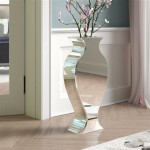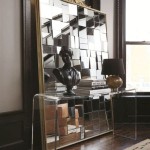French Rococo Style Full Length Mirror
The French Rococo style, flourishing from the 1730s to the 1770s, is renowned for its ornate asymmetry, delicate curves, and lighthearted themes. This aesthetic permeated all forms of decorative arts, including furniture, painting, sculpture, and mirrors. Rococo mirrors, particularly full-length examples, became quintessential elements of aristocratic interiors, serving both functional and decorative purposes.
Full-length mirrors, often referred to as cheval mirrors or pier mirrors, rose in popularity during this period. These mirrors offered a practical means for individuals to assess their appearance from head to toe, vital for the fashion-conscious elite of the 18th century. Simultaneously, these large, reflective surfaces amplified the natural light within a room, enhancing the overall sense of spaciousness and opulence.
Key Features of French Rococo Mirrors:
- Asymmetrical Designs
- Intricate Carvings
- C- and S-Scrolls
- Floral and Foliage Motifs
- Shell and Rockwork Elements (Rocaille)
- Gilding
- Use of Glass
Asymmetry reigns supreme in Rococo design. Mirrors from this period often feature unbalanced, yet harmonious, arrangements of scrolls, flowers, and other decorative elements. This departure from the strict symmetry of the preceding Baroque style creates a sense of movement and dynamism.
Carving is another hallmark of Rococo craftsmanship. Skilled artisans painstakingly carved intricate designs into the wooden frames of these mirrors. These carvings frequently incorporated C- and S-scrolls, characteristic curves that became synonymous with the Rococo style.
The natural world served as a primary source of inspiration for Rococo artists and designers. Floral and foliage motifs, often intertwined with the aforementioned scrolls, abound in Rococo ornamentation. Delicate blossoms, trailing vines, and acanthus leaves are common features.
The term "Rococo" itself derives from the French word "rocaille," referring to the shell-covered rockwork found in grottos and gardens. These natural formations influenced the decorative arts, leading to the incorporation of shell and rockwork elements in Rococo designs, including mirror frames. These motifs further enhance the organic and whimsical nature of the style.
Gilding, the application of gold leaf or paint, played a significant role in creating the luxurious appearance of Rococo mirrors. The glistening gold accentuates the intricate carvings and adds to the overall sense of opulence and grandeur. The warm glow of the gold also complemented the candlelight that illuminated interiors during this period.
Beyond the frame itself, the glass of the mirror often received special attention. While clear glass was standard, some Rococo mirrors incorporated etched or painted glass elements. These additions further personalized the piece and offered another avenue for artistic expression.
Rococo Mirrors in Interior Design:
- Focal Points in Salons and Bedrooms
- Placement Above Fireplaces and Consoles
- Contribution to the Overall Ambiance
Within the context of 18th-century interiors, full-length Rococo mirrors served as important focal points. They were frequently positioned in salons, bedrooms, and other prominent spaces. Their placement above fireplaces or console tables further emphasized their decorative importance.
The reflective qualities of these mirrors played a significant role in shaping the overall ambiance of a room. By reflecting both natural and artificial light, they brightened the space and created an illusion of greater size. The shimmering surfaces also added a sense of movement and sparkle to the interior.
Collecting and Caring for Rococo Style Mirrors:
- Antique vs. Reproduction Mirrors
- Importance of Provenance
- Professional Restoration
- Proper Cleaning and Handling
For those interested in acquiring a French Rococo style mirror, it’s important to distinguish between antique and reproduction pieces. Antique mirrors, originating from the 18th century, carry significant historical value and are often highly sought after by collectors. Reproduction mirrors, while not possessing the same historical significance, can still offer a beautiful and affordable way to incorporate the Rococo aesthetic into a modern interior.
When considering an antique mirror, provenance, or the documented history of ownership, is paramount. A clear and verifiable provenance adds to the mirror's authenticity and value. It provides insights into the object’s journey through time and connects it to specific historical periods and individuals.
Antique mirrors may require professional restoration to address issues such as damaged gilding, chipped carvings, or aged glass. It's crucial to seek the expertise of a qualified conservator who specializes in Rococo furniture and decorative arts. Improper restoration techniques can diminish the value and historical integrity of the piece.
Maintaining the beauty of a Rococo style mirror, whether antique or reproduction, requires careful cleaning and handling. Avoid harsh chemicals and abrasive materials, which can damage the delicate surfaces. Gentle dusting with a soft cloth is generally sufficient for regular cleaning.

French Mirror Baroque Rococo Antique

Extra Large Full Length Gold Rococo Dress Mirror Victorian Big Vintage Mirrors

Vintage Rococo French Louis Xvi Style Full Length Floor Mirror In Antique Gold Finish Chairish

Floor Mirror In French Style Sq0936508 Osman Antique

Vintage French Italian Rococo Louis Xv Style Gold Wall Mantle

Rococo Style Full Length Mirror Sq8166846 Osman Antique

Louis Large Gold Gilt Mirror French Rococo Silver Baroque Leaner Wall

Carved And Distressed Rococo Style Mirror For At Pamono

Vintage Ornate Gold French Mirror Renaissance Rococo Style Heavily Gilded 60 S

French Mirror Baroque Wall Antique Style Mirrors Gold








